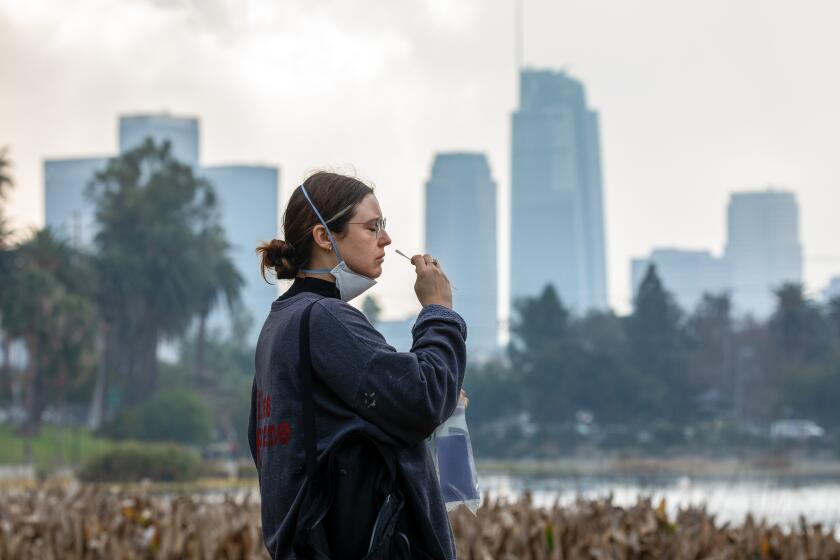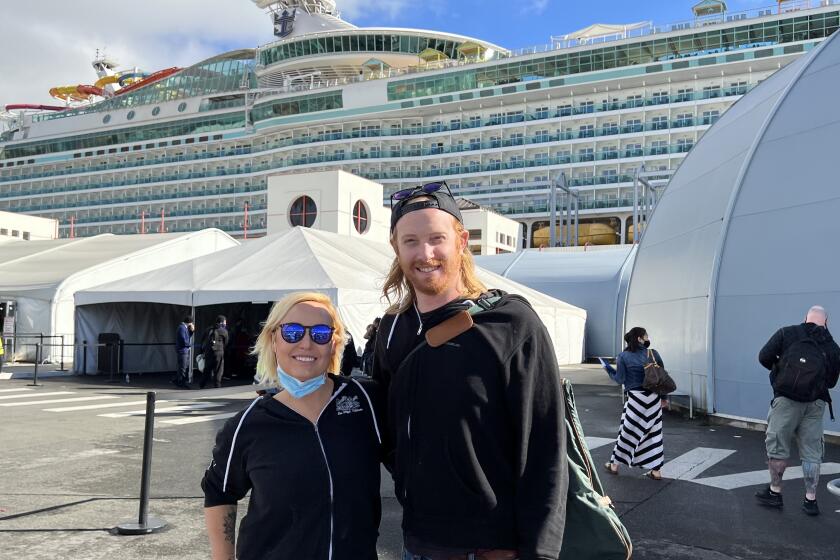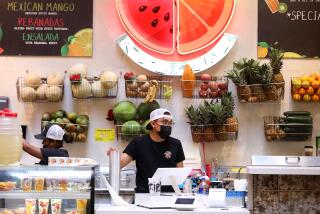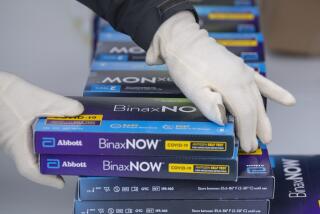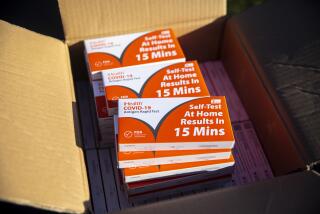Omicron leaves testing labs overwhelmed, causing frustrating delays to get results

The Omicron surge has created overwhelming demand for coronavirus tests. Laboratories and manufacturers have struggled to keep up.
- Share via
As the Omicron surge drives infection rates to record highs, testing has emerged as an essential tool for limiting its spread. But over the last month, laboratories and manufacturers have struggled to keep up with the demand.
In December, neighborhood pharmacies sold out of rapid antigen tests. Getting an appointment for the more sensitive and definitive PCR test took days, and results even longer. Once again, the pandemic had exposed a weakness in the country’s healthcare system.
“I think that unfortunately, we are as unprepared for the type of surge we are experiencing — from a testing perspective — as we were a year ago,” said Omai Garner, who directs the clinical microbiology testing laboratory for UCLA Health.
Free at-home coronavirus testing kits, now available to households around the country, promise to ease the bottlenecks, but questions over shortages and delays threaten to undermine confidence. Answers, however, lie in the numbers.
Before the surge, Garner estimated that his lab was processing about 700 PCR tests a day. Today that number is close to 2,000. Nor was his lab alone in its running at capacity.
“We had other waves in L.A. County, but this has surpassed all of them,” said Jennifer Dien Bard, director of Clinical Microbiology and Virology at Children’s Hospital Los Angeles. “We’ve doubled, if not more, the volume we had just a few months ago.”
The CHLA lab is now processing tests 24/7 and has tripled its staffing, and because the number of tests coming back positive is exceptionally high, testing volume will remain high for weeks ahead, turning lab managers into logistics experts as well.
“We’re trying to predict the future,” Dien Bard said, describing how she has had to maintain a balance between being prepared and not hoarding supplies that have an expiration date.
Both Garner and Dien Bard’s laboratories are among nearly 50 throughout the state operating within medical centers that serve patients and employees. The situation is even more complicated among the commercial labs that serve public testing sites throughout the state.
While California continues to see disturbing rises in COVID-19 hospitalizations and deaths, there are some early signs the Omicron wave is slowing.
These sites are managed by a variety of companies that greet patients, maintain software, collect and send specimens to off-site laboratories. In the first week of January, 81% of these laboratories returned results in an average of two days, according to the California Department of Public Health.
One lab, SummerBio, processed 358,340 tests during that week, averaging a less than one-day turnaround. The company has been dealing with surges of the virus since August, when the Delta surge pushed its volume from 10,000 tests per day to 100,000. The company, which provides testing for the Los Angeles Unified School District, flies specimens twice daily from Van Nuys to Palo Alto.
The Omicron surge presented a similar challenge, said Sasha Seletsky, SummerBio’s chief business officer and co-founder. The last week of December, testing volume had fallen to 8,000 when SummerBio’s primary clients — school and universities — were on break. The company had expected similar volume when the new year began.
Fulgent Genetics, which runs laboratories in Temple City and Houston, similarly saw its testing volume jump at the start of the year. Half of the 279,310 tests that it received the first week of the year took two days to process.
“Historically our turnaround time has been less than 24 hours. The demand was unprecedented,” said Brandon Perthuis, Fulgent’s chief commercial officer. “In a dynamic environment, scaling the business up and down is not instantaneous.”
Some commercial labs provided results in three to four days, and one took nearly two weeks, according to the state public health department.
Most health experts are largely sympathetic to the burden placed on labs and test administrators. Delays, they argue, have less to do with a lack of preparation than the virulence of the Omicron variant, which has resulted in employees calling in sick.
“On Jan. 6, an estimated six million Americans were infected by COVID,” said Dr. Buddy Creech, director of the vaccine research program at Vanderbilt University Medical Center in Tennessee. “There is no amount of preparation that would allow us to test six million a day for an infectious disease.”
At the start of the pandemic, the possibility of testing for the coronavirus was a more suspicious than promising enterprise.
Startups, taking advantage of lax oversight by the Food and Drug Administration, began marketing at-home tests that were not backed by scientific studies. Some had never been tested for reliability or accuracy.
If testing was slow to get started, said Dr. William Schaffner, an infectious-disease specialist at Vanderbilt University Medical Center, the promise of vaccines was to blame.
“We were absolutely entranced by the science and success of vaccine development,” Schaffner said. “So the vast amount of attention was placed on getting everyone vaccinated.”
As a result, Schaffner said, the public is less knowledgeable about both the PCR and the at-home rapid antigen tests. Each answers a slightly different question.
The PCR test provides definitive proof of a coronavirus infection, but because the test is so sensitive — amplifying trace elements of viral RNA — it registers the presence of the virus even it is not infectious.
As a result, “a PCR test can create confusion and incredulity,” Schaffner said. “You may get a positive test based on a viral remnant that can’t infect anyone.”
The PCR test, he added, is the “the gold standard” if someone has COVID-like symptoms and wants to know if it is COVID-19, but if someone wants to get released from quarantine or isolation, the at-home rapid antigen test is better.
But its limitation is its lack of sensitivity. “Because it does not have the capacity to take a little viral fragment and amplify it, there has to be a substantial amount of virus to turn the test positive,” he said.
Using an antigen test too early in the course of the infection will likely result in a negative reading even though the virus is present. Therefore, Schaffner and other medical experts recommend taking the test once, and if it comes back negative, test again 24 hours later.
Given the differences — and limitations — of the two tests, the U.S. Centers for Disease Control and Prevention did not make ending isolation or quarantine following an infection contingent upon testing, Schaffner said.
California, however, diverged from the CDC and put into place stricter recommendations than the federal agency. Whereas the CDC required formerly infected people to wear masks for five days, the California Department of Public Health called for a negative test five days or more after symptoms have subsided.
Whether this recommendation has played a role in the delays now being experienced is unclear. The state described the current surge as “a fluid situation, and we are monitoring the science and data in order to respond accordingly, including regarding testing requirements.”
But from the perspective of Romney Humphries, professor of pathology at Vanderbilt University Medical Center, California’s approach is not in keeping with reality.
“We are not at a place in this country where we have an excess of testing material to do that,” she said.
The meteoric rise in Omicron-driven infections is raising questions as to whether it’s still safe to cruise.
Humphries is having to manage supply availability day to day, as Vanderbilt competes with labs around the world for testing reagents and cartridges.
“We would like to have a week of supplies, but we have less than two days of supplies on hand,” she said. “We’re just burning through them as quickly as they come through the door.”
So far as the challenge comes down to supply and demand, argues Dr. Robert Kim-Farley, a professor at the UCLA Fielding School of Public Health, the lulls and surges of the pandemic put undue pressure on manufacturers to respond accordingly.
He cited, as an example, Abbott Laboratories, maker of the at-home antigen test BinaxNow, which closed a manufacturing and assembly facility in Illinois last June due to lack of demand. Three months later the company reopened the facility.
“I think a lesson learned is that we cannot rely solely on private industry and market demand in the midst of a pandemic,” he said.
The situation is comparable to the shortages in PPE that occurred at the start of the pandemic. “You can’t expect private manufacturers to produce and stockpile things that will never be sold or used,” Kim-Farley said. “This is the role of government, and what we need to prepare for is a new variant.”
Garner, with UCLA Health, agrees.
“Labs have to go from a normal level of testing to three times or 10 times more in a surge,” he said. “It is a very difficult ask. Everyone should have access to PCR tests that we can turn around in 24 hours. That is what a federal response should look like.”
As healthcare experts predict new variants on the horizon, the need for such safeguards is more important than ever, Garner said.
More to Read
Sign up for Essential California
The most important California stories and recommendations in your inbox every morning.
You may occasionally receive promotional content from the Los Angeles Times.
